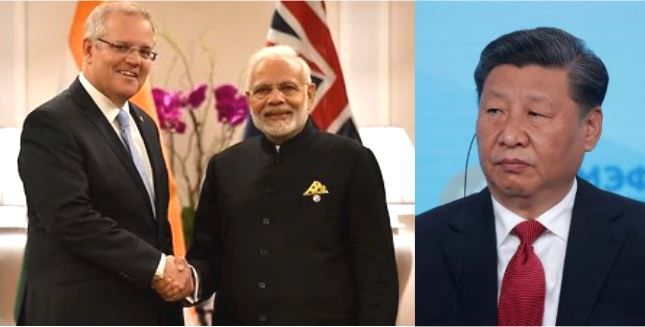The world wants to change- it wants to get rid of Chinese hegemony. And the alliance that seems all set to punish the Dragon is the Indo-Australia alliance. At a plain geo-strategic level, they can jeopardise Chinese trade routes like never before.
Earlier this month, PM Narendra Modi held a virtual summit during which the two countries finalised the Mutual Logistics Support Agreement. This allows the Navies of the two countries to access each other’s ports for logistics such as food, water, and petroleum.
This should get China worried at a time when Beijing is engaged in a tense military stand-off with India in Eastern Ladakh. As per latest reports, Chinese build-up has yet again started in Galwan Valley Patrolling Point-14 (PP-14). This is the same spot where bloodshed happened on June 15 leading to 20 casualties on India’s side, and far more casualties on China’s side.
Clear Chinese build-up at PP14, Galwan Valley. Chinese debris on June 16, return of Chinese camps visible on June 22. Latter image shows tentage + gun positions (marked). Images via @detresfa_. Important to see what has happened in 2 days since Lt Gen talks. pic.twitter.com/O9Wqj1rb6e
— Shiv Aroor (@ShivAroor) June 24, 2020
Meanwhile, China has also been engaged in a severe trade war with Australia. Beijing has imposed tariffs on imports of meat and barley from Australia. Australia-China ties have soured further as Beijing is facing allegations of launching a massive cyber-attack on Canberra.
This is the reason why relations between India and Australia keep getting stronger, as their ties with China get embittered.
New Delhi and Canberra can weaponise their strategic importance in the Indo-Pacific to hamper China’s trade routes and oil imports.
To make it amply clear, India’s Andaman & Nicobar Islands are situated on the northwestern approaches of the Strait of Malacca. This is a strategic choke point in the Indian Ocean that connects the Indian and Pacific Oceans. It is a narrow stretch of water between the Indonesian Island of Sumatra and the Malay Peninsula.
China’s exports to Middle East, Africa and Europe pass through this strategic chokepoint. If and when India blocks this strategic choke point, Chinese exports through the Indian Ocean could run into trouble.
More importantly, the country that blocks the Strait of Malacca can hamper the Chinese economy by blocking its oil imports.
Beijing is dependent on oil imports for economic growth, and in fact, it is the biggest oil importer in the world.
Strait of Malacca happens to be the second busiest oil chokepoint in the world, next only the Strait of Hormuz.
Interestingly, 80 per cent of China’s oil imports pass through the South China Sea via the Strait of Malacca.
https://bpr.berkeley.edu/2019/08/26/the-malacca-dilemma-a-hindrance-to-chinese-ambitions-in-the-21st-century/
However, the only issue is that India’s territorial waters are limited to the North-western approaches of the Strait, while much of the vast South-eastern approaches to the Malacca Strait remain a blind spot for India.
Consequently, the Indonesian Straits- Sunda, Lombok, and Ombai-Wetar also lie outside India’s traditional sphere of influence in the Indian Ocean Region (IOR).
In case of a conflict, if India tries to disrupt China’s access to energy resources, Beijing can potentially bypass India’s area of influence through other Indonesian Straits.
But this is where Australia and the Mutual Logistics Pact between New Delhi and Canberra become crucial.
If China tries to bypass India’s area of influence around the Strait of Malacca and import oil through other Indonesian Straits, India’s friend Australia can block China’s access.
The Cocos Islands in the Australian external territory lie close to the Indonesian Straits and this would mean that oil imports to China stand fully blocked.
https://www.britannica.com/place/Cocos-Islands
This explains the growing ties between India and Australia. Both the countries perceive China as a threat. For India, China’s hegemony translates into aggression in the Himalayas.
On the other hand, Australia detests Chinese bullying in the South China Sea. India and Australia have underscored that they have a shared vision which ensures freedom of navigation. This is crucial for Canberra as it wants to protect freedom of navigation in the South China Sea as a trade route.
At a purely geo-strategic level, Indo-Australian cooperation is thus the biggest disaster-in making for China.








